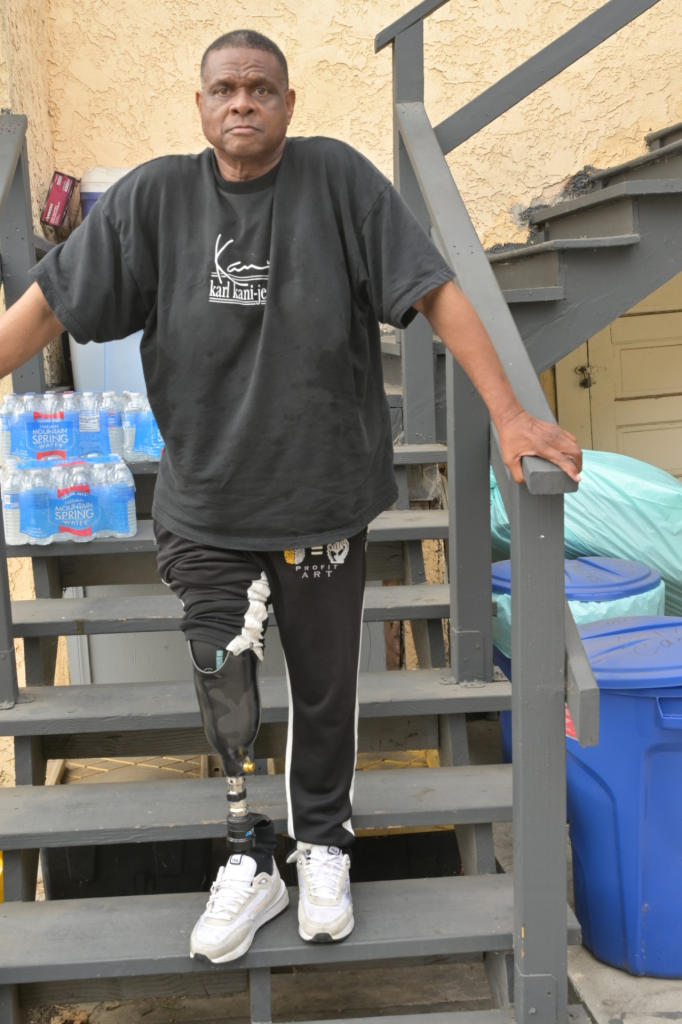Advice
Tips to be Fit: Most germs won’t hurt us, but 1,400 can
THE PHILADELPHIA TRIBUNE — Did you know there are over 65,000 known germs, but only about 1,400 cause disease? The four major types of germs are bacteria, viruses, fungi and protozoa. They can infect our bodies and cause disease. There is a difference between infection and disease. We can be infected without being diseased.
Did you know there are over 65,000 known germs, but only about 1,400 cause disease?
The four major types of germs are bacteria, viruses, fungi and protozoa. They can infect our bodies and cause disease. There is a difference between infection and disease. We can be infected without being diseased.
An infection is the first step, which occurs when bacteria, viruses or other microbes that cause disease enter our body and begin to multiply. Disease is when the cells in our body are damaged as a result of the infection, and symptoms of an illness appear.
Most germs won’t hurt us. Our immune system protects us against infections. But germs may mutate and breach the immune system. Knowing how germs work will reduce your risk of infection.
Bacteria are one-celled organisms. They are visible only with a microscope. Not all bacteria are harmful. Some bacteria live in our body and are helpful, such as Lactobacillus acidophilus, which lives in our intestines and helps us digest food, destroys some disease-causing organisms and provides nutrients.
Disease-causing bacteria will produce toxins that can damage cells and make you ill. Some bacteria directly invade and damage cell tissues. Some infections caused by bacteria include strep throat, tuberculosis and urinary tract infections.
Viruses are much smaller than our cells. Viruses are organisms that contain only genetic material. To reproduce, viruses invade cells in our bodies and change how our cells work. Most host cells are eventually destroyed during this process, which can kill us.
Viruses are responsible for causing numerous diseases, including AIDS, the common cold, Ebola hemorrhagic fever, genital herpes, influenza, measles, chickenpox and shingles.
Antibiotics for bacteria have no effect on viruses.
There are many varieties of fungi. Fungi are organisms that are reproduced by spores. We eat a number of them, such as mushrooms. The mold that forms the blue or green veins in some types of cheese are also fungi. So is yeast, the ingredient that makes bread rise.
Some fungi can also cause illness. Fungi are also responsible for skin conditions such as athlete’s foot and ringworm.
Protozoans
A protozoan is a single-celled organism that acts like a tiny animal. Protozoans eat other microbes for food. A few types of protozoans are found in our intestinal tract and are harmless.
Protozoans spend part of their life cycle outside the host. Protozoans live in food, soil, water and insects. Some protozoans invade our bodies through food or water we consume.
Some cause diseases such as giardia, malaria and toxoplasmosis. The protozoan that causes malaria is transmitted by a mosquito.
Infectious diseases
An easy way to contract most infectious diseases is by coming in contact with a person, animal or object that has the infection. Three ways infectious diseases can be spread through direct contact are:
Person to person: This is the most common way for infectious diseases to spread is when a person infected with the bacterium or virus touches, kisses, coughs on or sneezes on someone who isn’t infected. The germs can also spread through the exchange of body fluids from sexual contact. People who pass germs may have no symptoms of their disease.
Animal to person: Getting bitten or scratched by an infected animal can make you sick. It can be fatal in extreme situations. Handling animal waste can make you sick. You can acquire a toxoplasmosis infection by scooping your cat’s litter.
Mother to unborn child: A pregnant woman can pass germs that cause infectious diseases to her unborn baby. The germs can pass through the placenta connecting mother and baby. Germs in the vagina can be transmitted to the baby during birth.
Bacteria, viruses, fungi and protozoa can enter our bodies through:
- Skin contact or injuries.
- Inhaling airborne germs.
- Consuming contaminated food or water.
- Tick or mosquito bites.
- Sexual contact.
You should get medical care if you suspect that you have an infection and you have experienced any of the following:
- An animal or human bite
- Difficulty breathing
- A cough lasting longer than a week.
- Periods of rapid heartbeat.
- A rash, especially if accompanied by a fever.
- Blurred vision or other difficulty seeing.
- Persistent vomiting.
- An unusual or severe headache.
- Reducing risk of infection
The CDC recommends the following to help reduce your risk of becoming infected:
Wash your hands. This is especially important before and after preparing food or drinks, before eating or drinking, after using the toilet, and after removing soiled clothes or shoes. Try not to touch your eyes, nose or mouth with your hands, as that’s a common way germs enter the body. Soap and water work well to kill germs. Wash for at least 20 seconds and rub your hands briskly. Disposable hand wipes or gel sanitizers also work well. Gel sanitizers and hand wipes should be 70% alcohol-based.
Get vaccinated. Immunization can drastically reduce your chances of contracting many diseases. Make sure to keep up to date on your recommended vaccinations, as well as your children’s.
Stay home when ill. Don’t go to work if you are vomiting, have diarrhea or have a fever. Don’t send your child to school if he or she has these signs and symptoms, either.
Prepare food safely. Keep counters and other kitchen surfaces clean when preparing meals. Cook foods to the proper temperature using a food thermometer to check for doneness. For ground meats, that means at least 160 degrees F (71 C); for poultry, 165 F (74 C); and for most other meat, at least 145 F (63 C). In addition, promptly refrigerate leftovers. Don’t let cooked foods remain at room temperature for extended periods of time.
Practice safe sex. Always use condoms if you or your partner has a history of sexually transmitted infections or high-risk behavior.
Don’t share personal items. Use your own toothbrush, comb and razor. Avoid sharing drinking glasses or dining utensils.
Travel wisely. If you’re traveling out of the country, talk to your doctor about any special vaccinations.
If you work out in a gym, be careful. You are exposed to a lot of people. You are using equipment that was just used. Clean the padding before you use it. More than 50% of healthy persons have Staphylococcus aureus living in or on their nasal passages, throats, hair and skin.
Swimming can be dangerous, too. The average swimmer contributes at least 0.14 grams of fecal material to the water within the first 15 minutes of entering the pool. Showering with soap before swimming helps stop the spread of germs by removing fecal material from the body.
You should also make sure your gym has good air circulation. We can’t wash the air in a gym, but the exchange of air should be good.
Pets and other animals
Got a pet? Be careful. To reduce the risk of getting sick from germs your pets may carry, always wash your hands after:
• Touching or playing with your pet.
• Feeding your pet or handling pet food.
• Handling pet habitats or equipment (cages, tanks, toys, food and water dishes, etc.)
• Cleaning up after pets.
• Leaving areas where animals live (coops, barns, stalls, etc.), even if you did not touch an animal.
Going to the zoo this season? Try to make it safe:
• Don’t walk and eat. Your hands will touch a lot of contaminated objects.
• Don’t let your little one use a pacifier. They touch that pacifier with everything. They may even share it with an animal.
• Wipe off any seating or table you use in the zoo.
• Don’t feed the animals from your hand.
• If you have an open wound, cover it completely.
• Try not to come into contact with any animal waste. It’s teaming with germs.
This article originally appeared in The Philadelphia Tribune.
Activism
Essay: Intentional Self Care and Community Connections Can Improve Our Wellbeing
At the deepest and also most expansive level of reality, we are all part of the same being, our bodies made from the minerals of the earth, our spirits infused by the spiritual breath that animates the universe. Willingness to move more deeply into fear and pain is the first step toward moving into a larger consciousness. Willingness to move beyond the delusion of our separateness can show us new ways of working and living together.

By Dr. Lorraine Bonner, Special to California Black Media Partners
I went to a medical school that was steeped in the principles of classical Western medicine. However, I also learned mindfulness meditation during that time, which opened me to the multifaceted relationship between illnesses and the interconnecting environmental, mental and emotional realities that can impact an individual’s health.
Therefore, when I began to practice medicine, I also pursued training in hypnosis, relaxation techniques, meditation, and guided imagery, to bring a mind-body focus to my work in medical care and prevention.
The people I saw in my practice had a mix of problems, including high blood pressure, diabetes, and a variety of pain issues. I taught almost everyone relaxation breathing and made some general relaxation tapes. To anyone willing, I offered guided imagery.
“My work embraced an approach to wellness I call “Liberatory Health” — one that not only addresses the treatment and management of disease symptoms but also seeks to dismantle the conditions that make people sick in the first place.”
From my perspective, illness is only the outermost manifestation of our efforts to cope, often fueled by addictions such as sugar, tobacco, or alcohol, shackled by an individualistic cult belief that we have only ourselves to blame for our suffering.
At the deepest and also most expansive level of reality, we are all part of the same being, our bodies made from the minerals of the earth, our spirits infused by the spiritual breath that animates the universe. Willingness to move more deeply into fear and pain is the first step toward moving into a larger consciousness. Willingness to move beyond the delusion of our separateness can show us new ways of working and living together.
To put these ideas into practical form, I would quote the immortal Mr. Rogers: “Find the helpers.” There are already people in every community working for liberation. Some of them are running for office, others are giving food to those who need it. Some are volunteering in schools, libraries or hospitals. Some are studying liberation movements, or are working in urban or community gardens, or learning to practice restorative and transformative justice, or creating liberation art, music, dance, theater or writing. Some are mentoring high schoolers or apprenticing young people in a trade. There are many places where compassionate humans are finding other humans and working together for a better world.
A more compassionate world is possible, one in which we will all enjoy better health. Creating it will make us healthier, too.
In community, we are strong. Recognizing denial and overcoming the fragmenting effects of spiritual disorder offer us a path to liberation and true health.
Good health and well-being are the collective rights of all people!
About the Author
Dr. Lorraine Bonner is a retired physician. She is also a sculptor who works in clay, exploring issues of trust, trustworthiness and exploitation, as well as visions of a better world.
Activism
Prescribing Prevention: Doctors Turn to Lifestyle, Herbs and Veggies to Protect Against Chronic Illness in Black Californians

By Charlene Muhammad, California Black Media
Leibo Glover received his diabetes diagnosis at the same time he found out he needed a below-the-knee amputation.
“Minor,” thought the 63-year-old.
Glover had been self-medicating a toe injury before seeing the doctor.
But while driving from South Los Angeles to Miami on a family trip, an infection set in.
“I had it but didn’t know,” said Glover. “I was just going to come back to California, but they told me if I had left, I would have come home as a corpse,” Glover told California Black Media (CBM).
A majority of the nearly 3.5 million Californians diagnosed with diabetes have preventable Type 2 diabetes, according to researchers at the UCLA Center for Health Policy Research.
In 2023, diabetes was diagnosed in 1 in 6 adults with the lowest incomes (16.7% at 0–99% of the federal poverty line), compared to 1 in 11 adults with the highest incomes (8.9% at 300% or more of the federal poverty line). Age is a factor, too: more than 1 in 5 older adults age 65 and over (22.3%) had diabetes, about twice the rate of adults age 18–64 (8.6%).
Another study by Health Economics and Evaluation Research (HEER) mapped patients with diabetes in California who had amputations. Researchers found that patients living in low-income ZIP codes were far more likely to have had lower-limb amputations than those in higher-income ZIP codes, essentially identifying amputation “hot spots.”
At the time of Glover’s 2018 diagnosis, he was experiencing housing instability and going through financial hardships. Now, he has more stable housing and he has improved his health through lifestyle changes like eating healthier and getting more sleep.
“If the equipment is right, I can stand on my leg for hours. I can actually run, jump, dance and all of that,” said Glover, who got his diabetes under control, in part, by avoiding carbohydrates and sugars.
As chronic illnesses continue to disproportionately impact Black Californians — often leading to preventable amputations and premature deaths — a growing number of doctors and advocates are expanding their care from just treatment to including prevention. From promoting diet and lifestyle changes to cultivating community farms focused on prevention and wellness like Dr. Bill Releford’s Bloom Ranch in Acton.
Releford, a podiatrist based in Los Angeles started the 250-acre Bloom Ranch in 2023 as part of his strategy for preventive care.
“This is my assignment,” said Releford.
“Bloom Ranch has been a perfect backdrop for me to be creative and to find avant-garde ways to make fresh fruits and vegetables more accessible to food deserts in Los Angeles County,” he stated.
California produces nearly half of the nation’s fruits and vegetables, yet more than 1 in 5 Californians — about 8.8 million people — currently struggle with food insecurity, according to the California Association of Food Banks.
“Studies have shown that 75% of amputations are preventable. And African Americans have the highest amputation rate in the nation,” Releford said.
As such, Releford continued, the mortality rate associated with high-level amputation is 50%, which means “if we had 10 people that all had high level amputations, five of those would be deceased in three years.”

Monday, June 28, 2025. Leibo Glover at his home in Los Angeles, California. The security professional’s leg was amputated below the knee.
Releford’s ranch is the largest Black-owned farm in L.A. County. He plans to partner with UCLA and the Charles R. Drew University of Medicine and Science to develop prescriptive vegetable boxes.
“Certain vegetables and herbs can lower blood pressure naturally, like beets, turnips, dill, basil, garlic and others,” said Releford.
“Hopefully, this will inspire other farmers to take this model and replicate it across other urban areas,” Releford added.
“A lot of studies have shown that gardening has so many health benefits – being in the sun, Vitamin D,” said Releford. “The dirt has a lot of microbes that are good for your immune system. Studies have shown that people who work in the dirt have strong immune systems.”
Gardening can potentially decrease the risk of dementia, enhance cognition, reduce stress, and boost immunity, indicates research by Genoa Barrow of the University of Southern California Center for Health Journalism as part of the 2024 Ethnic Media Collaborative, Healing California.
During a recent picturesque day at Bloom Ranch, families, school children, farmers and members of The Ultimate Book Club 1998, founded by Alina Anderson, sampled and purchased fresh produce while taking photographs.
“This is huge. “All of us have families that could use this information,” said Anderson.
Doctors like Releford, who are committed to tackling the most chronic diseases impacting all their patients utilize peer-to-peer support programs with self-management training led by individuals living with chronic conditions to provide role models and support for patients, according to a recent study by the California Health Care Foundation.
“The unifying feature of these programs is that they seek to build on the strengths, knowledge, and experience that peers can offer,” the report states.
Liz Helms, CEO of the California Chronic Care Coalition, addressed state-backed prevention policy and initiatives.
“It’s in horrible shape. It needs to get so much better, especially in underserved areas, where the Black population has a whole set of different needs,” she said.
Helms, who started advocacy after being denied access to care in the early 1990s, applauded new developments in telehealth. The opportunity to choose between visiting a doctor’s office or placing a phone call makes a difference, especially if there are transportation or distance issues, or if one is too sick, she said.
Fear is one thing people, especially in the Black community, must overcome, emphasized Helms.
“I had to get over my fear of going to the doctor, of not speaking up,” continued Helms, urging patients to “understand the baseline” of their health.
“Don’t let anyone stigmatize you or tell you that you’re not good enough to get care or look down on you. Everyone has a right to good, quality, affordable, timely health care,” said Helms.
To engage Bloom Ranch for preventive care focused on wellbeing and healthy living, call (323) 388-4828 or sign up at Bloomranchofacton.com
Activism
Learning Life’s Lessons
Since his release over five years ago, Richard has committed himself to making a difference, particularly by reaching out to women and families who lack the presence of a father or husband. He knows he cannot undo the years lost behind prison walls, but he is determined to use his past to build a better future for others. His story mirrors that of many who have walked a similar path. Yet, it remains uniquely his own – a testament to the power of change, resilience, and the belief that even from tragedy, something good can emerge.

“California’s three-strike laws gave me 2 life sentences for drug possession. After serving 28 years, mostly in solitary confinement, I am free to lead a movement to get the formerly incarcerated to give back.”
By Richard Johnson
I have written this book in hopes of being able to help others from not traveling down the path that leads to imprisonment or a cemetery. At the very beginning of writing this book, it began as a message to my son Fati Yero Gaidi, who was only two years old at the time that I was given two life sentences in prison for drug possession, under the newly implemented three-strikes-you-out law. The more that I wrote, the book began to evolve beyond its intended purpose for my son; it became something that any and everyone could utilize on their separate journeys through life challenges that we encounter. The book helped me put my thoughts, reasoning, perceptions, and views on display, while opening doors that, for the most part, were closed. The book can be purchased via Amazon. Learning life lessons.
About the Author
By Post staff
Richard “Razor” Johnson, 74, is a man whose life journey is marked by hard-earned wisdom, redemption, and an unshakable commitment to guiding the next generation. Once sentenced to life under California’s Three Strikes Law, he was released through what he calls nothing short of divine intervention. His time behind bars, particularly in Pelican Bay State Prison, gave him a new raw and unfiltered understanding of life’s hardest truths.
With the realization that time is precious and the future is shaped by the lessons we learn, Richard writes with urgency and purpose. His book—a 300-page labor of love—is dedicated to young men who may not have a father to teach them the meaning of life’s most important words. Through definitions filled with wisdom, experience, and deep personal insight, he offers direction to those who find themselves lost, just as he once was.
Since his release over five years ago, Richard has committed himself to making a difference, particularly by reaching out to women and families who lack the presence of a father or husband. He knows he cannot undo the years lost behind prison walls, but he is determined to use his past to build a better future for others. His story mirrors that of many who have walked a similar path. Yet, it remains uniquely his own – a testament to the power of change, resilience, and the belief that even from tragedy, something good can emerge.
His words are not just lessons; they are a call to action. He hopes that by investing in young minds with wisdom and insight, they will be better equipped to navigate life’s trials, learn from their mistakes, and find their path to success. Richard “Razor” Johnson writes not just to be heard, but to help – because he knows firsthand that sometimes guidance can make all the difference.
Post publishers Paul and Gay Cobb visited Johnson in San Quentin and attended his graduation while he was in prison. He became a columnist with the Post News Group and has continued his advocacy for the formerly incarcerated by urging them to “give something back”. Johnson says he will be speaking at prisons, colleges, and media outlets to help organize voter registration and community service projects.
-

 Activism3 weeks ago
Activism3 weeks agoOakland Post: Week of November 12 – 18, 2025
-

 Activism4 weeks ago
Activism4 weeks agoOakland Post: Week of November 5 – 11, 2025
-

 Activism2 weeks ago
Activism2 weeks agoIN MEMORIAM: William ‘Bill’ Patterson, 94
-

 Activism3 weeks ago
Activism3 weeks agoHow Charles R. Drew University Navigated More Than $20 Million in Fed Cuts – Still Prioritizing Students and Community Health
-

 Bay Area3 weeks ago
Bay Area3 weeks agoNo Justice in the Justice System
-

 #NNPA BlackPress3 weeks ago
#NNPA BlackPress3 weeks agoThe Perfumed Hand of Hypocrisy: Trump Hosted Former Terror Suspect While America Condemns a Muslim Mayor
-

 #NNPA BlackPress2 weeks ago
#NNPA BlackPress2 weeks agoTrump’s Death Threat Rhetoric Sends Nation into Crisis
-

 #NNPA BlackPress3 weeks ago
#NNPA BlackPress3 weeks agoProtecting Pedophiles: The GOP’s Warped Crusade Against Its Own Lies


























































